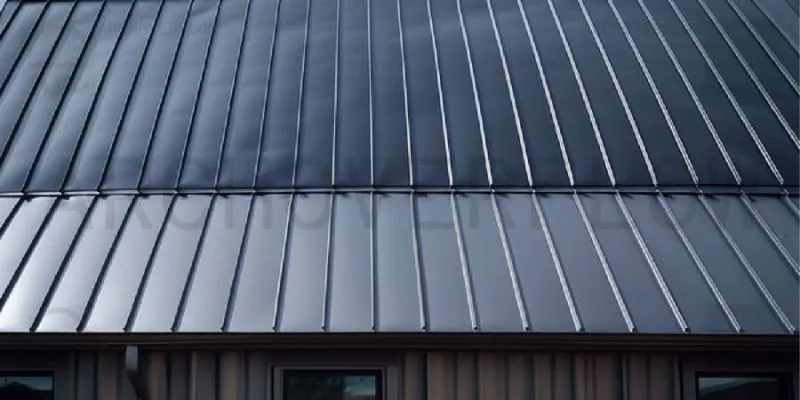Metal roofing is popular for its durability and sleek appearance. However, one common issue is oil canning. This article will explain what oil canning is, why it occurs, and how to prevent it. We’ll also discuss solutions if your roof is already affected.
What Is Oil Canning?
Oil canning refers to the visible waviness in the flat areas of metal roofing panels. This distortion is unsightly and can impact the aesthetic appeal of your roof. It’s often more noticeable in certain lighting conditions and can affect various types of metal roofs, including aluminum, steel, and copper.
Causes of Oil Canning
Oil canning is caused by several factors:
- Thermal Expansion: Metal expands and contracts with temperature changes. This movement can cause stress and lead to oil canning.
- Improper Installation: Incorrect fastening methods and inadequate spacing can contribute to oil canning.
- Material Defects: Manufacturing flaws in metal sheets can result in uneven surfaces.
- Structural Issues: Irregularities in the roof deck or framing can cause metal panels to buckle.
Signs of Oil Canning
It’s important to recognize the signs of oil canning early. Look for these indicators:
- Visible waves or ripples on the metal surface
- Distortion that changes with different angles of sunlight
- Uneven reflections on the roof
Prevention Tips for Oil Canning on Metal Roof!
Preventing oil canning involves careful planning and execution. Here are some tips:
- Choose the Right Material: Opt for thicker metal panels that are less prone to bending.
- Proper Installation: Ensure correct fastening techniques and adequate spacing between panels.
- Use Striations: Adding ribs or striations to metal panels can reduce the visibility of oil canning.
- Control Thermal Movement: Use clips that allow for thermal expansion and contraction.
Solutions for Existing Oil Canning
If your roof already shows signs of oil canning, there are steps you can take:
| Solution | Description |
| Refastening Panels | Adjusting the fasteners to relieve stress on the panels. |
| Replacing Affected Panels | Replacing severely distorted panels with new ones. |
| Adding Striations | Introducing ribs or grooves to existing panels. |
What to Look for Before & During Metal Roof Installation
Installing a metal roof is a significant investment. To ensure a successful project, it’s important to know what to look for both before and during the installation process. This guide will help you navigate the key factors and avoid common pitfalls.
Pre-Installation Considerations
Before installation begins, there are several crucial steps to take:
Choosing the Right Material
Selecting the appropriate metal for your roof is essential. Consider the following:
- Durability: Different metals have varying lifespans. Steel is durable but may rust if not properly coated. Aluminum is resistant to corrosion but can dent more easily.
- Climate Suitability: Some metals perform better in certain climates. For instance, aluminum is ideal for coastal areas due to its resistance to saltwater corrosion.
- Aesthetic Appeal: Choose a metal that complements your home’s architectural style.
Inspecting the Roof Deck
Ensure the underlying structure is sound:
- Check for Damage: Look for signs of rot, mold, or structural damage.
- Ensure Flatness: A level roof deck is crucial for proper metal panel installation.
- Verify Support: Ensure the deck can support the weight of the metal roof.
Selecting a Qualified Contractor
Hiring an experienced contractor is key to a successful installation:
- Verify Credentials: Ensure the contractor is licensed and insured.
- Check References: Look at past projects and read customer reviews.
- Get Multiple Quotes: Compare prices and services to get the best value.
During Installation
As the installation begins, there are several aspects to monitor to ensure a high-quality job:
Proper Fastening Techniques
Correct fastening is vital to prevent future issues:
- Spacing: Ensure fasteners are spaced correctly to allow for thermal expansion.
- Tightness: Fasteners should be secure but not overly tight, which can cause warping.
- Sealing: Use appropriate sealants to prevent leaks.
Alignment and Overlap
Proper alignment ensures the roof’s integrity:
- Straight Panels: Ensure panels are aligned straight and evenly.
- Correct Overlap: Panels should overlap correctly to prevent water ingress.
- Consistent Pattern: Maintain a consistent pattern for a uniform look.
Managing Thermal Movement
Metal roofs expand and contract with temperature changes. Properly managing this movement is crucial:
- Use Clips: Clips allow for movement without stressing the panels.
- Leave Gaps: Small gaps between panels can accommodate expansion.
- Monitor Installation Conditions: Install on days with moderate temperatures to avoid extreme expansion or contraction.
Quality Control
Regular inspections during the installation process can catch issues early:
- Inspect Fasteners: Check that all fasteners are properly installed and sealed.
- Check Panels: Look for any signs of waviness or oil canning.
- Evaluate Workmanship: Ensure the overall workmanship meets high standards.
Post-Installation Checklist
Once installation is complete, perform a final check:
- Water Tightness: Test for leaks by simulating heavy rainfall.
- Finish Quality: Ensure the finish is uniform and free of scratches or dents.
- Clean Up: Verify the site is clean and free of debris.
Why Choose Us?
We understand the intricacies of metal roofing. Our team uses the best materials and techniques to ensure your roof is both functional and beautiful. If you’re facing oil canning or any other roofing issues, we’re here to help.
Hasid On The Roof Houston is your go-to expert for all metal roofing needs. Whether you’re dealing with oil canning or need a new roof installation, we’re here to help. Our team is dedicated to providing top-notch service and ensuring your roof remains durable and attractive. Contact us today to learn more about our services and how we can assist you.

